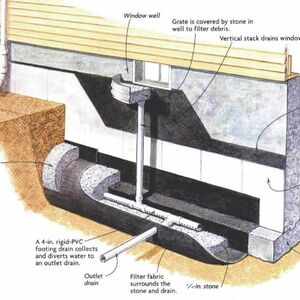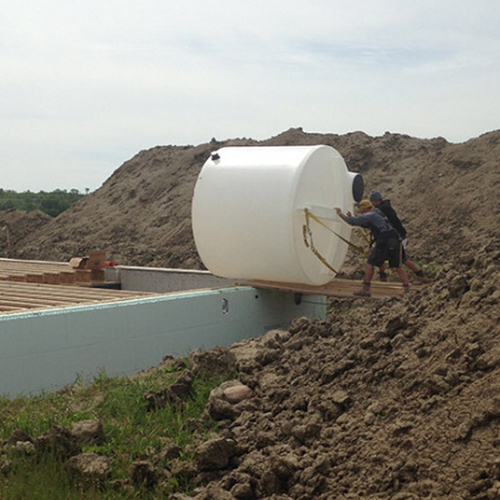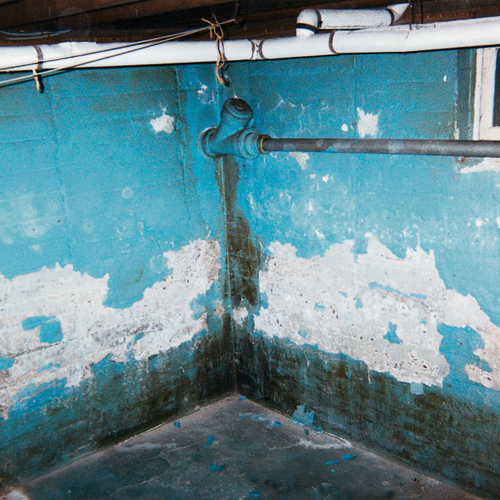
Many delightful older homes have a serious flaw: namely, a damp basement. These humidity problems can be mild (musty smells and a clammy feeling) to severe (flowing water or frequent puddles). So how can these flaws be remedied?
Solutions can be divided into two general categories. This article will address exterior solutions, while a future article will address interior solutions.
How does water enter a basement?
In most climates, the soil outside a basement foundation is always damp. Moreover, most basement walls—including poured concrete walls, concrete block walls, stone walls, and brick walls—allow moisture to enter your basement. The moisture can enter as a liquid (through small cracks in the wall) or as a vapor (because concrete and masonry walls are vapor-permeable). When soil is saturated with water, the hydrostatic pressure of the water on the outside of your wall increases. (Hydrostatic pressure is the pressure exerted by a fluid due to gravity. Hydrostatic pressure increases in proportion to the depth of the fluid, measured from the fluid’s surface, because of the weight of the fluid exerting downward force from above.) When this hydrostatic pressure is particularly high, as it might be when the soil is saturated due to a heavy rainstorm or rapid snow melt, water can trickle or squirt into your basement through cracks in the wall, or appear on the basement floor as a puddle.
Some sites have an additional problem: the presence of a subsurface spring that flows continuously or seasonally. Such springs rise from below, and they can show up in a basement as a small trickle or a major flow.
Code requirements for new homes
New homes with basement foundations are required by most building codes to have a footing drain system as well as dampproofing compound on the exterior side…
Weekly Newsletter
Get building science and energy efficiency advice, plus special offers, in your inbox.

This article is only available to GBA Prime Members
Sign up for a free trial and get instant access to this article as well as GBA’s complete library of premium articles and construction details.
Start Free TrialAlready a member? Log in















6 Comments
Martin, we are so grateful to you for this article. We want very much to have our foundation excavated down to the footing, then a parge coat of cement applied to the fieldstones (they are quite heterogenous in projection), then perforated drain tile laid, water barrier applied, exterior insulation, etc. I have called every "wet basement" contractor near my zip code, including the one who dug full perimeter *interior* trench and laid perforated pipe going to sump. No "wet basement" contractor in my area seems amenable to the messy, disruptive, exterior basement work we hope to have done. Per your suggestion in a previous (recent) post, I left messages with some excavation contractors but none has returned my call. Any suggestions of a contractor in the tristate NH-MA-VT intersection who does basement work from the outside? We dont care about disruption to our landscaping; we just want our basement kept dry and warm, and the interior work we had done is not making the cut. Thanks
Anonymous,
You're on the right track, and I don't have many suggestions. To find excavation contractors, visit your local Ready-Mix plant (concrete plant) or sand-and-gravel quarry and ask for suggestions. Or you can talk to local builders -- most builders know the names of excavation contractors. Even landscaping companies can provide good leads. Keep talking to everyone you know.
Thank you, Martin, for these helpful suggestions.
Martin, you have been invaluable to the industry for many years! One added thought if/when folks dig around their foundation. THAT is the time to consider exterior insulation as well. And mineral wool boards might be able to serve dual purpose by providing that drain plane (vs. Drain mat) along with thermal resistance. Lower Global warming impact and less risk of ant invasion vs. XPS. Even homes with lightly used basements benefit from the added warmth as combustion equipment down there use less energy and you get more comfort of warmer floors.
I am in the process of waterproofing a daylight basement. The walls are cinderblock and the mortar joints were very poorly done when it was built 30 years ago. I have excavated the exterior and have the basement gutted to block and slab on the inside. I intend to waterproof the exterior with AFM dynoseal after repairing the mortar and then adding 2 layers of pink foamular board to the outside of that. I will install an exterior french drain terminating in a sump with pump and backfill with drain cinders. I am stuck at flashing the siding to the foam board (which is 2" proud of the siding). What type of flashing should be used and where can I get it. I was envisioning a z flashing but can't find the right dimensions. I live in Flagstaff, AZ on volcanic soils on the side of a mountain that generally drain well but we have been having water pool in the basement. All water from the roof in now being properly managed. We bought this house 6 months ago and the downspouts all drained right on the basement walls! This will be a finished bedroom when the project is done. Any other insight is also appreciated.
B Tremp,
Q. "I am stuck at flashing the siding to the foam board (which is 2" proud of the siding). What type of flashing should be used and where can I get it? I was envisioning a Z flashing but can't find the right dimensions."
A. Any contractor with a brake (a tool for bending sheet metal) should be able to make the Z-flashing you need. Most roofers own a brake, so you could hire a roofer for the job. Another option: Most towns and cities have a sheet-metal shop where you can order flashing in any profile. Ideally, the flashing would be made from stainless steel or 16-ounce copper, but stiff aluminum or factory-painted galvanized steel would do in a pinch.
Log in or become a member to post a comment.
Sign up Log in